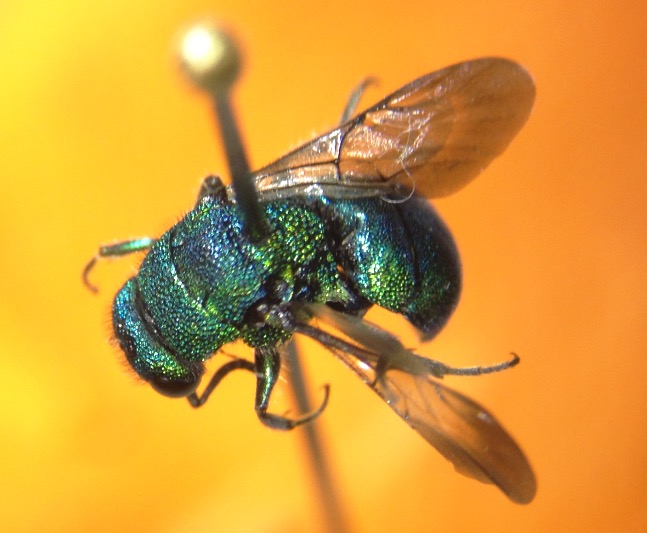Look at this beautiful, harmless fly. So sparkly, so nice. Wait, is that a second pair of wings? Why, this isn’t a fly at all – it’s the deceptive cuckoo wasp!
Cuckoo wasps are parasitic wasps of the family Chrysididae: very beautiful and very dangerous, at least to other insects. There are thousands of species split up among 4 subfamilies: Chrysidinae, Cleptinae, Amiseginae, and Lobosceliniidae. Chrysidinae is the largest subfamily, so we’ll focus on them, but we can touch on the others as well!
Parasite – An organism that lives in or on another organism (a host) in order to feed off of it
Parasitoid – A parasite that kills its host over time
Chrysidinae
Have you heard of the cuckoo? It’s a bird that will lay its eggs in another bird’s nest so that the other bird, none the wiser, will raise the cuckoo’s young for it. Free babysitting! Species of Chrysidinae, the largest subfamily of cuckoo wasps, do something pretty similar – they will lay their eggs inside the nests of other wasps or bees (or moths and butterflies, in some species) and then buzz off. The cuckoo wasp eggs hatch quickly and devour all the food that was left there for the host’s offspring, leaving nothing left and causing the other larvae to starve when they do hatch. This is known as kleptoparasitism since the parasite is stealing stored up food. In some cases, the parasite will even feed on the other larvae in the nest before it leaves! In these cases, we would consider the species to be a parasitoid.

A perfect Chrysidinae specimen. Why do you think these wasps are coloured so brightly?
Arnstein Staverløkk – Flammegullkvefs (Chrysis Viridula) – Wikimedia Commons (CC BY 3)
Since these little guys are nest parasites, they can often be found crawling around in sandy or muddy areas looking for wasp nests. Most cuckoo wasps live in sand or dirt (as do their hosts), and so you’ll have the best luck finding them in sandy areas. If you happen to live near a desert, that would be a great spot to hike out to with your camera or net! Don’t bother with setting up near a hive – cuckoos only prey on solitary wasps, as breaking into a colony would be way too dangerous!

Notice how this cuckoo wasp’s abdomen is beginning to curl under the rest of its body – members of the subfamily Chrysidinae can roll up into balls when disturbed, which can help protect them from angry hosts that catch them in the act.
Parker Smale – Sparkles, Stabbed – Personal Collection
Other Sub-Families
It’s harder to find and catch species from the other three subfamilies since they’re less abundant (especially if you live in Canada), so these wasps don’t find their ways into many collections. Nonetheless, we still do know a little bit about them.
Amiseginae. There is only one species of Amiseginae in Canada, but there are many more in tropical regions, where they parasitize stick bugs. While most parasites and parasitoids are host-specific, many Amiseginae females are more generalist and will take whatever they can get, wandering around on the forest floor and in dead tree trunks looking for walking stick eggs to break into. They lay their eggs directly inside of the walking stick eggs, killing their previous occupants and making their larvae parasitoids.
Cleptinae
Despite “clept-” appearing in their name, members of this subfamily aren’t actually kleptoparasites – they are ectoparasitoids. Females will lay their eggs inside of sawfly cocoons, where their babies will hatch and latch onto the sawflies while they are in the prepupa stage. They live on the outside of the prepupa, feeding off of it until it dies.
Host-Specific – The parasite only parasitizes a specific species
Generalist – The parasite will parasitize anything that it can
Ectoparasitoid – A parasitoid that lives on the outside of its host
Prepupa – An inactive stage between larva and pupa
Lobosceliniidae
Very little is known about Lobosceliniidae, the smallest subfamily, but we do know that they aren’t metallic and that they parasitize stick bugs in a similar way to Amiseginae. Unless you live in Asia or Australia, you probably won’t see one of these! I was surprised to even find a picture, as there are only 20 species world-wide.

Species from the sub-family Lobosceliniidae aren’t metallic and sparkly like their relatives, but that’s not as lame as it sounds! Gere’s a picture to so you can see that they’re still cool. Look at those antennae! That jacked thorax!
Alex Wild – Male Loboscelidia sp. in Queensland, Australia – Wikimedia Commons (CC BY 3)
Should I be Scared?
Short answer: no. While cuckoo wasps can be dangerous to host larvae and eggs, relatively few species are predatory towards other insects, let alone dangerous to humans. We think that most of them feed on flower nectar, and though some of them snack on the fluid inside of host eggs before laying their own eggs inside, they’re not about to bite any people. Additionally, their stingers are generally very small, and so you probably don’t need to worry about being stung when handling them. If you have any insect relatives that are expecting, though, definitely link them to this article.
Resources and further reading:

